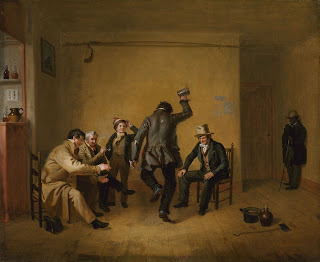 She applied the “Page 99 Test” to her new book, America Walks into a Bar: A Spirited History of Taverns and Saloons, Speakeasies and Grog Shops, and reported the following:
She applied the “Page 99 Test” to her new book, America Walks into a Bar: A Spirited History of Taverns and Saloons, Speakeasies and Grog Shops, and reported the following:Having never heard of the Page 99 test, I was pretty terrified when I cracked my book open to that page. What if Ford was correct? What if his test would reveal some awful truth about my efforts? Had I known about the test, I’d have tried to make sure something good landed there.
I was very pleased to discover, however, that page 99 is one of my favourite pages. First off, it’s the opening page to the second part of the book, which is where I think things really get rolling. Not that there’s anything wrong with Part One, it’s just that the book is a chronological history of the American bar, and it’s harder to tell a really exciting story about what happened in bars during the years when people were far too busy ekeing out an existence to chronicle what happened the night before in the bar-room. Now, thanks to Twitter and Last Night’s Party we have clear records of what everyone said at every moment and what every drink and drunk looked like. That said, however, I realize that this surfeit of data will probably lead to far worse problems for a future bar chroniclers.
But somewhere in between the revolutionaries, whose best line seems to have been “Where we met to Plan the Consignment of a few Shiploads of Tea, Dec 16, 1773” and today’s party people, whose best line seems to be "Am I missing a tooth?" some smart people wrote down some of the witty things said in bars. And some of my favourite stories are to be found in Part Two, specifically Chapter Six, which is called “Keeping Tabs.”
“Keeping Tabs” is also the chapter which people in the industry will appreciate the most – a detailed account of what the bar was evolving into, with less of the political action that dominates the rest of the book. Don’t get me wrong, I love the politics and the whole point of the book is that America’s most interesting and progressive political movements – republican democracy, anarchism, gay pride, to name a few – were largely conceived of and planned in bars. Still, I worry that the detailed account of the tap-room as political sphere will begin to try the patience of some industry folk who will really want to know non-political details like who was serving what to whom and what the physical structure of the bar looked like. This chapter is there, in part, to round things out and provide such information for those who want that kind of detail.
There are few words on page 99. Twenty-nine, to be precise. You already know two of them. Then, we see this lovely painting by William Sidney Mount:
Then, the caption:Visit Christine Sismondo's blog, and learn more about America Walks into a Bar at the Oxford University Press website.
BARROOM SCENE BY WILLIAM SIDNEY MOUNT, 1835
Happy times in a simple tavern. As always, a wait for the bathroom.
I have never looked at this caption without laughing out loud. I know it’s not cool to laugh at your own jokes but, since it’s not my joke, it’s okay. It was produced in the sleep-deprived editing stages, by my husband who added it, I think, as a joke, to wake me up and distract me from my bleary-eyed editing. I then put it in as a joke for my editor to see, thinking he might remove it. He never did. At the page-proof stage, I had a pang of remorse and wrote the assistant. She passed it on, but it was (obviously) never removed. I guess everyone liked it, perhaps for the same reasons I do.
Namely, that it’s one of the few jokes in the book. Library Journal reviewed my book and called it “pun-laden,” which I really don’t understand, since I don’t recall a single pun – but it was a favourable review so I won’t complain. The point is, since this book is an attempt to treat bars seriously – as radical political spaces and valuable community centres – it’s not like a lot of alcohol books, which are pretty firmly planted in the humour branch of writing. In America Walks into a Bar, I strive for levity, but not jokes, per se. But we snuck this one in – as a reward for the careful caption reader.
And, now, I guess, anyone who reads this.
--Marshal Zeringue




